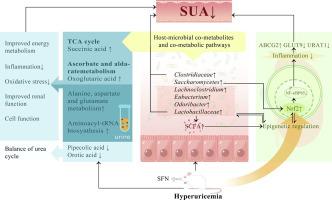Journal of Advanced Research ( IF 10.7 ) Pub Date : 2022-11-10 , DOI: 10.1016/j.jare.2022.11.003 Ruoyu Wang 1 , Mairepaiti Halimulati 1 , Xiaojie Huang 1 , Yuxin Ma 1 , Lutong Li 1 , Zhaofeng Zhang 2

|
Introduction
Currently, revealing how to prevent and control hyperuricemia has become an essential public health issue. Sulforaphane has a wide range of applications in the management of hyperuricemia.
Objective
The study objective was to verify the uric acid-lowering effects and the regulation of the gut-kidney axis mediated by sulforaphane and identify host-microbial co-metabolites in hyperuricemia.
Methods
A hyperuricemia model was established by administering feedstuffs with 4% potassium oxonate and 20% yeast. Forty male Sprague–Dawley rats were randomly divided into the normal control, hyperuricemia, allopurinol, and sulforaphane groups. Animals were treated by oral gavage for six consecutive weeks, and then phenotypic parameters, metabolomic profiling, and metagenomic sequencing were performed.
Results
Sulforaphane could lower uric acid by decreasing urate synthesis and increasing renal urate excretion in hyperuricemic rats (P<0.05). We identified succinic acid and oxoglutaric acid as critical host-gut microbiome co-metabolites. Moreover, sulforaphane improved the diversity of microbial ecosystems and functions, as well as metabolic control of the kidney. Notably, sulforaphane exerted its renoprotective effect through epigenetic modification of Nrf2 and interaction between gut microbiota and epigenetic modification in hyperuricemic rats.
Conclusion
We revealed that sulforaphane could ameliorate the progression of hyperuricemia by reprogramming the gut microbiome and metabolome. Our findings may provide a good means for efficiently preventing and treating hyperuricemia.
中文翻译:

萝卜硫素驱动的肠道微生物组和代谢组重编程可改善高尿酸血症的进展
介绍
当前,如何防治高尿酸血症已成为重要的公共卫生问题。萝卜硫素在高尿酸血症的治疗中具有广泛 的 应用 。
客观的
该研究的目的是验证萝卜硫素介导的降尿酸作用和肠肾轴调节作用,并鉴定高尿酸血症中的宿主-微生物共代谢产物。
方法
通过饲喂含4%氧酸钾和20%酵母的饲料建立高尿酸血症模型。40只雄性Sprague-Dawley大鼠随机分为正常对照组、高尿酸血症组、别嘌呤醇组和萝卜硫素组。连续六周对动物进行口服灌胃治疗,然后 进行表型参数、代谢组学分析和宏基因组测序。
结果
萝卜硫素可通过减少高尿酸血症大鼠尿酸合成、增加肾脏尿酸排泄来降低尿酸(P<0.05)。我们确定琥珀酸和氧化戊二酸是关键的宿主-肠道微生物组共代谢物。此外,萝卜硫素改善了微生物生态系统和功能的多样性,以及肾脏的代谢控制。值得注意的是,萝卜硫素通过 Nrf2 的表观遗传修饰以及高尿酸血症大鼠肠道微生物群与表观遗传修饰之间的相互作用发挥其肾脏保护作用。
结论
我们发现萝卜硫素可以通过重新编程肠道微生物组和代谢组来改善高尿酸血症的进展。我们的研究结果可能为有效预防和治疗高尿酸血症提供良好的手段。


























 京公网安备 11010802027423号
京公网安备 11010802027423号